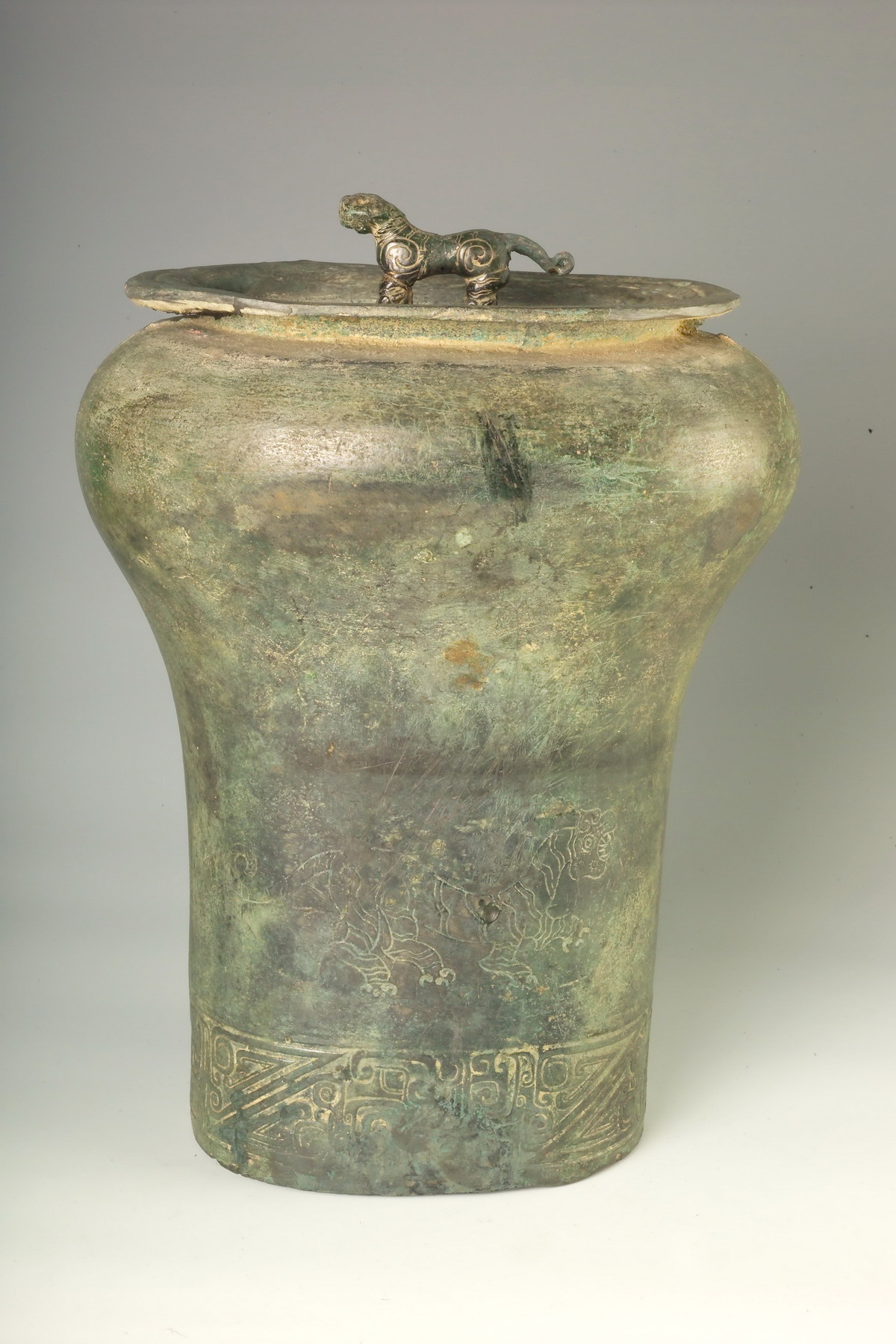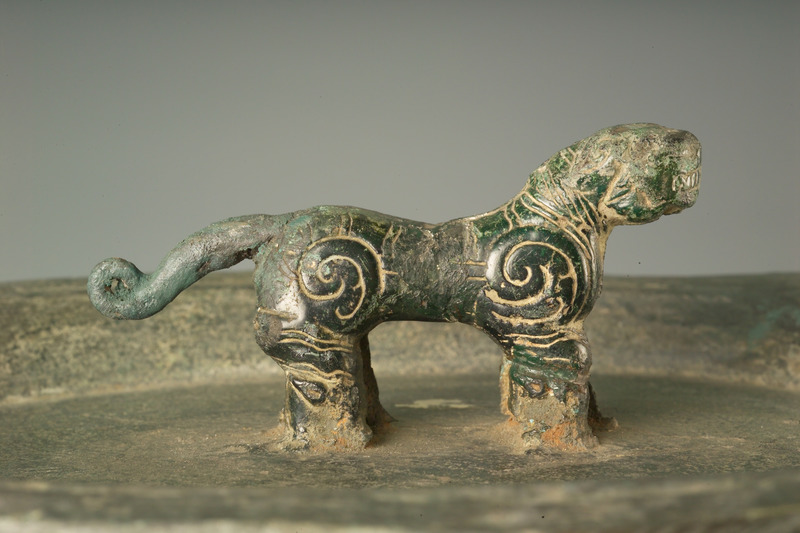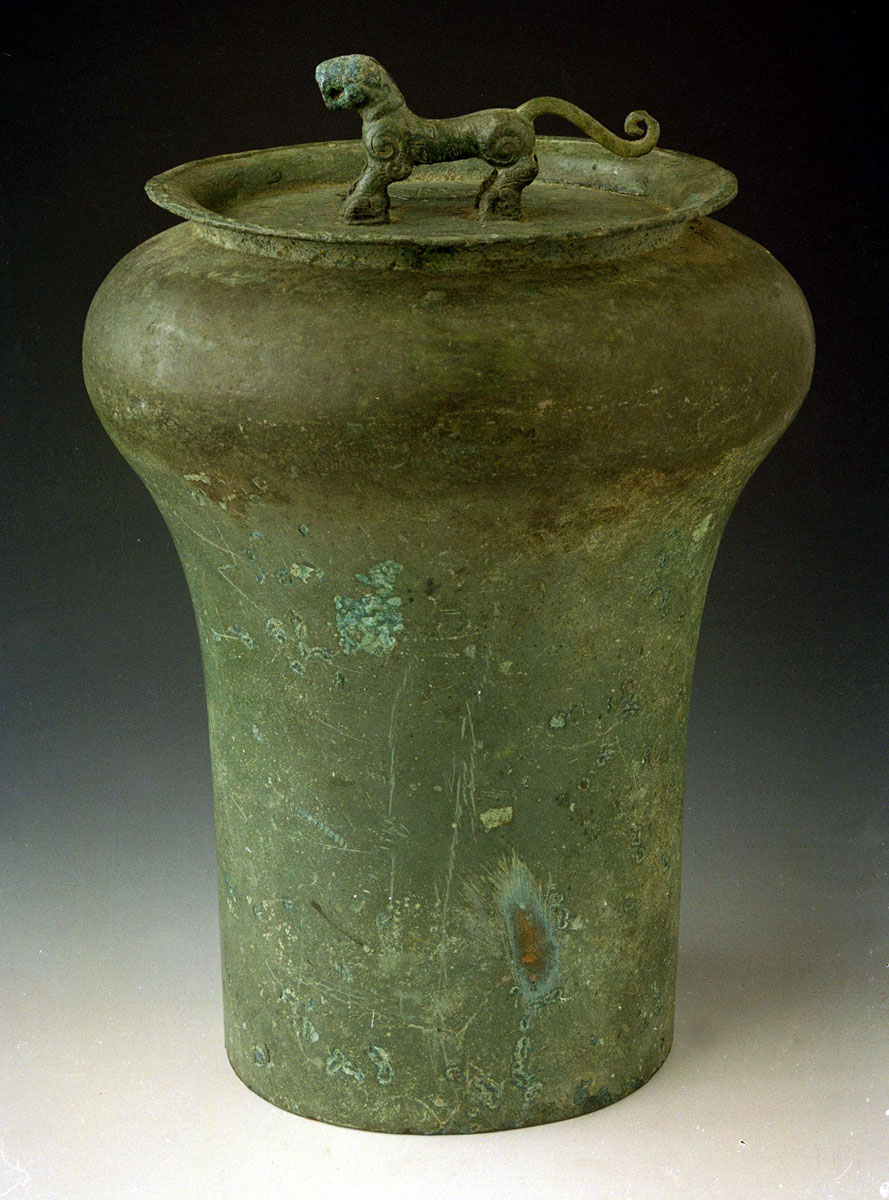Bronze Chunyu with a Handle in the Form of Tiger
Bronze Chunyu with a Handle in the Form of Tiger
Warring States Period( 476 BC-AD 221)
Height 35cm. width of shoulder 29cm. abdominal diameter 22-27.8cm.
Collected from a scrap copper depot in Zhuzhou in 1958
The ware is in the shape of a garlic, with an oval top with an outward lip, a flat base. A carved tiger with raised curl tail stands in the middle of the flat top, there is a collar on its neck, and the tiger's body is decorated with cloud patterns. The tiger’s shoulders are in the shape of a round drum, which is wider than its straight hollow body, the abdominal cross-section is oval, the tiger’s head is engraved with sun patterns, its mouth is open, the teeth are exposed, and the curl tail is long. The tiger is in a marching state. The bottom of the ware is decorated with inclined cloud patterns. A fusion line extending from the top can be seen on both sides of the body. The ware is light green and partly rusted.


深入探索
1.About Chunyu
The name of Chunyu (Chunyu refers to an ancient musical instrument) was derived from Zhouli (a Chinese ritual book). As for the basic styles of Chunyu, Ma Chengyuan divided them into six forms.
2. About the origin and spread of Chunyu
It is generally believed in the academic circle that the transmission route of Chunyu should be from north to south and from east to west. From the archaeological findings, the earliest Chunyu was unearthed in the mid-Spring and Autumn Period in Liujiadianzi, Yishui, Shandong Province. In the late Spring and Autumn Period, Chunyus were unearthed in some places of Anhui Province and Jiangsu Province. There are some controversies in academic circles about Chunyus’ dissemination and types, the main views are as follows:
The first is the "Dongyi (particular name for the tribes of the Eastern China) Theory". For example, Xu Zhongshu and Tang Jiahong believed: "Some areas of the Shandong Peninsula seem to be important native places of Chunyus, and their masters may be people from Dongyi." "The spread of Chunyu was gradually introduced from the Yellow River Basin in North China to the Yangtze River in South China."
The second is the "Yue (an ancient ethnic group in China) Theory". For example, Xiong Chuanxin deemed: "The appearance of Chunyu seems to be related to the Yue people, and it is also possible that the Yue people were the founders of casting ancient Chunyu." "By the Warring States Period, Chunyu had spread from the lower reaches of the Yangtze River to the Central Plains, and had been widely used. It could be used as a musical instrument in the Central Plains." This view is the exact opposite of the "Dongyi Theory".
The third is the "Miaoman (ancient ethnic groups in China) Theory". For example, Tong Enzheng believed that "Chunyu should be created by the local Miao and Man ethnic groups", and speculates that "the Dan ethnic group may be the one to use Chunyu."
The fourth is the "Chu(an ancient ethnic group in China) Theory". For example, Gao Zhixi thought: "From the perspective of the transmission route of Chunyu, it should be spread from north to south, and then to the west. The Chunyu was forged and used by the Chu people since Chu was a necessary place for the westward transmission of the Chunyu."
3. Function
Chunyu is an ancient military musical instrument, often used in conjunction with drums to command advance and retreat in war. As a military musical instrument, it was mostly used in battlefields to command troops and boost morale.
In terms of the musical characteristics, Chunyu is a percussion instrument, and its musical performance is relatively simple. Generally, Chunyu does not have a fixed rhythm. When hitting its shoulder, the sound is thunderous and clear for a long time. As for the way of playing, Chunyu is tied with a rope and hung from a stand to make a sound by striking it. In the bamboo slips of the Han tomb in Mawangdui, Changsha, there is a record of "hitting the Chunyu".
4.Tiger-shaped Handle and Ba People
The Xiangxi region of Hunan Province is one of the regions with the largest number of Chunyus unearthed in cellars. According to incomplete statistics, since 1949, 51 Chunyus have been unearthed in the Xiangxi region, except for one Chunyu with horse handle and three with ring handles, all of which are Chunyus with tiger handles. There are more than 30 Chunyus in the Hunan Museum, of which 18 are with tiger handles. The majority of these are from the Han Dynasty. In 1980, a Chunyu with tiger handle was unearthed from the Hunan, along with a Bronze Zheng (an ancient musical instrument) and a Bronze Bell (an ancient musical instrument) , as well as Chu-style earthenware jars with a long neck and a round bottom. This Chunyu is collected in the Hunan Museum, it is light green, tall and heavy, with a tiger handle in the plate.
The tiger handle on the top should be related to the historical legends of the Ba (an ancient ethnic group). The ancient Ba worshiped the white tiger, which should be the totem of the Ba. Chunyu was used for major ceremonial activities for unions and offering sacrifices.

The reason why the Chunyus with tiger handles were mostly unearthed on river banks, hillsides, under trees or in caves, in addition to being used for rituals, a significant portion of them might also be attributed to the defeat or evacuation of the Ba. The Ba people used the Chunyus with tiger handles on the battlefield, probably to inspire warriors. At the same time, Chunyus were also a symbol of the ancient Ba people's nature like a tiger and the spirit of bravery. Since ancient times, the ancient Ba people have been known for their humility, simplicity, martial arts and fighting skills.
相关评论
参考文献
1,高至喜:《楚式錞于初论》,《湖南省博物馆馆刊》第3期2006年。
2,朱世学著:《巴式青铜器的发现与研究》,科学出版社2015年。
3,傅聚良:《汉代武陵蛮的敲击乐器》,《华夏考古》2001年第2期。
4,冯汉骥:《云南晋宁石寨山出土铜器研究——若干主要人物活动图像试释》,《考古》1963年6期。
5,李衍垣:《錞于述略》,《文物》1984年8期。




